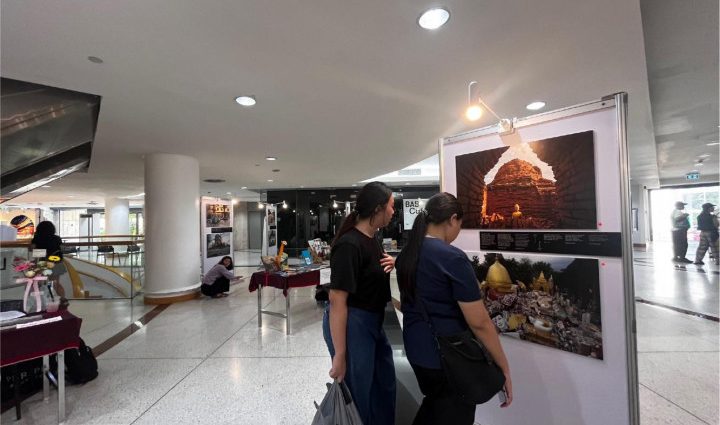
Imagine standing before a centuries-old pagoda as it shakes and crumbles into dust. In that instant, the world you knew vanishes as families run down the street in panic.
This was Mandalay on March 28, at 12.50pm, when a 7.7-magnitude quake ripped through central Myanmar, leaving more than 5,000 dead, thousands injured and over 120,000 homes levelled.
The “7.7 MMERQK: Capturing Myanmar People’s Unheeded Cry” exhibition brings those moments of terror and courage into stark focus.
Curated by Platform 36 in collaboration with SEA Junction, CMB Foundation and Bangkok Tribune News, the exhibition features images by four Myanmar-based photographers, two professionals and two citizen journalists, who risked aftershocks, political reprisals and the junta government’s censorship to document the quake’s first week in Mandalay, Sagaing and Nay Pyi Taw cities. Their mission: to educate and mobilise.
“We want visitors to leave the gallery not just informed but emotionally engaged,” said Rosalia Sciortino, Founder and Executive Director of SEA Junction, a programme of the Foundation for Southeast Asia Studies at the Bangkok Art and Culture Centre.
The photographs on display have never been run in any mainstream outlets. Wandering past a series of four images at the back wall, one can see a set showing a mother bathing her daughter in the Irrawaddy river beside the collapsed Ava Bridge, with the child’s hand clutching a battered steel bowl.
Nearby, a picture shows a congregation of Muslims kneeling on the street amid the debris during Ramadan near a crumbled mosque where religious services once took place.
These powerful visuals speak to the resilience of Myanmar’s people, continuing to carry on with life even in the quake’s aftermath.
“The people cannot pray inside any more, the mosque is gone, but they continue to pray outside,” Dr Rosalia said. “They were praying during Ramadan on a Friday when the mosque collapsed.”
On a black panel, visitors can read photographer Linkar’s own words: “At one point, I saw a doctor performing CPR on a child, trying to save her life. I couldn’t take a photo — then, the moment she went limp, I managed one shot. I broke down. All I could do was take photos and cry. That was the only thing I could do.”
In a nation still haunted by the 2021 coup and the civil war, these photographers risk jail or worse whenever they press the shutter.
“They have to be very careful,” Dr Rosalia says. “Most of our photographers are in Mandalay; only a few are in Nay Pyi Taw. Though the earthquake affected up to the Shan state, the photographer cannot expose it because they can be easily identified.”
Furthermore, each photographer hides behind a pseudonym, an act of quiet courage, knowing that the government brands their images as “negative publicity” and that revealing their real names could cost them everything.
Dr Rosalia said the exhibition also reveals a deeper truth: in quake-shattered towns, there is virtually no official help from the government.
“They are showing that there is no help; there is nothing. I mean, as you can see, they are doing everything themselves, they have to clean up, they are doing everything by themselves; no help. They are even throwing disinfectant over the corpses to prevent infections and disease as they cannot remove the debris,” she said.
Even when the government received international aid, it rarely reached communities fractured by the ongoing conflict. The government doesn’t distribute resources fairly, making people-to-people support essential.
Back at the exhibition, Dr Rosalia shows a panel featuring two heart-wrenching photographs stacked above each other. In the first, medics in mint green scrubs can be seen frantically cradling a limp, seemingly unconscious child.
Below, a photo shows a close-up of a young girl’s wide, haunted eyes as trembling hands pressed fresh bandages on a gaping wound on her scalp.
“Those two are very [graphic],” Dr Rosalia said, “we didn’t know if we should put them [up], but we decided to — to show everyone the reality of what happened.”
Moreover, in the wake of the quake, Myanmar’s National Unity Government, the civilian government opposing the military regime, declared a two-week pause in offensive operations to allow relief work. Yet the junta has continued its air strikes against rebel forces, compounding the devastation.
By focusing funds on both clinical and preventative health services, the exhibition aims to ensure that every baht donated helps save lives in Myanmar’s hardest-hit communities.
The “7.7 Earthquake: Capturing Myanmar People’s Unheeded Cry” exhibition runs from May 6 to Sunday in Corner Space on the 1st floor of the Bangkok Art and Culture Centre.
Visitors can also support the cause by purchasing limited edition prints and exhibition booklets, with 100% of the proceeds going directly to trusted aid groups in Myanmar, said Dr Rosalia.
To donate via bank transfer, please use: TTB Bank account number 0431077502; account name Foundation for Southeast Asia Studies.

